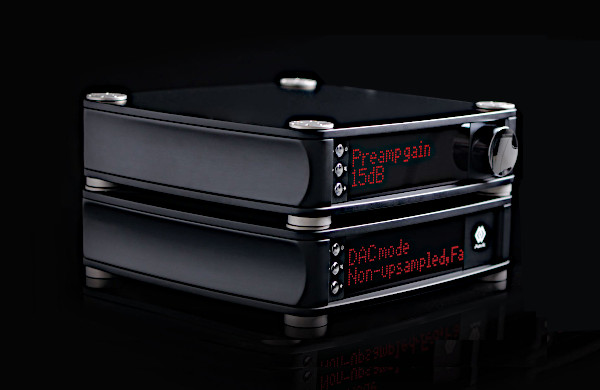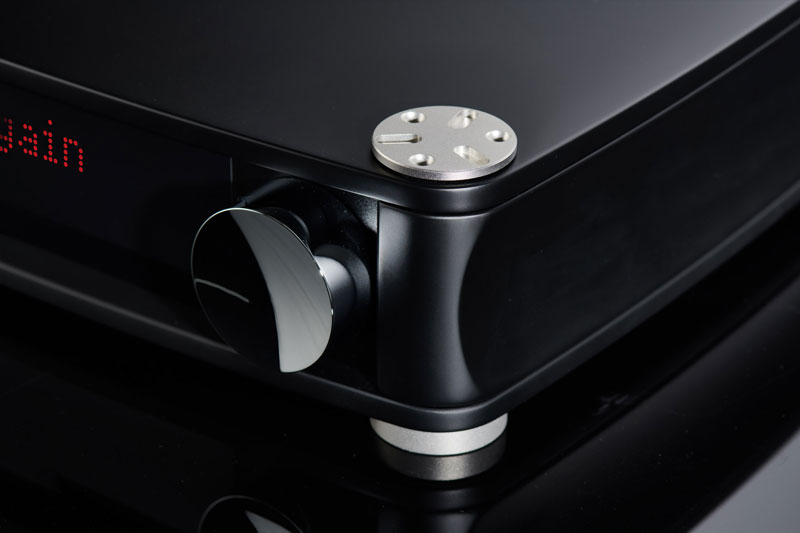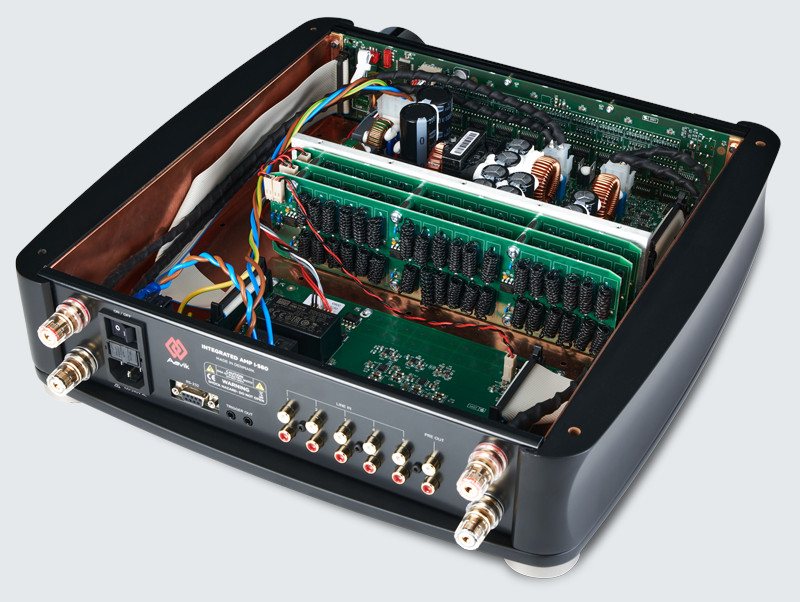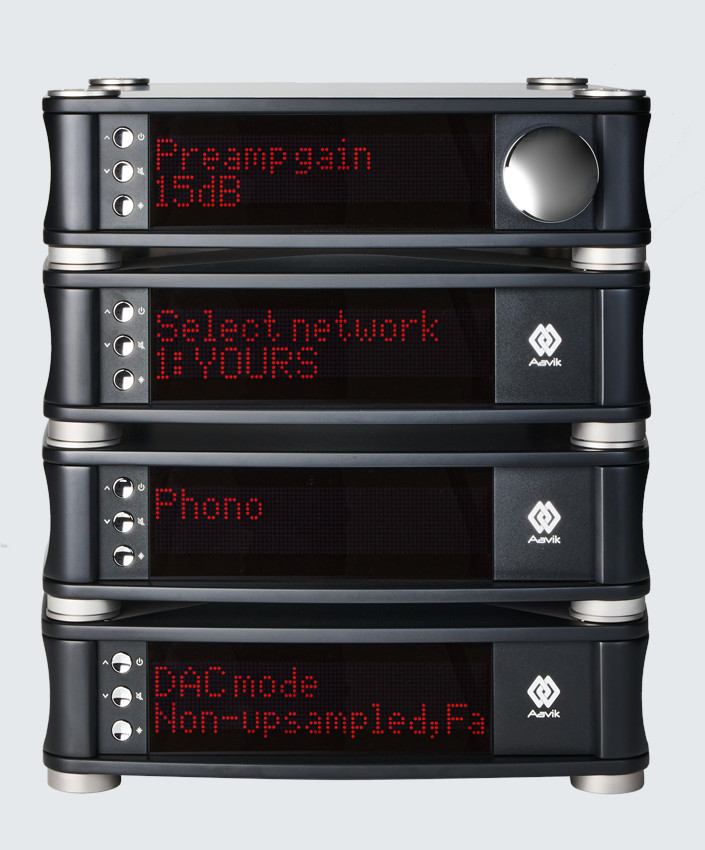AAVIK I-280
Integrated amplifiers
As far as its function is concerned the I-280 is an old-school integrated amplifier for audiophile purists. On the rear panel it has five single-ended RCA inputs, a preamplifier output, and speaker posts. The amplifier can be controlled by a large rotary knob and three buttons, alternatively by the Apple wand that is enclosed. However, the Aavik is far from old school inside.
Funkce a forma
There were several things (apart from its sound) that I liked about the I-280. With Class D becoming more prominent the high-end gets more compact. The massive boxes with cooling fins and ample perforation are gone and the amps do not function as an ancillary heating any longer. After the first three hours of listening the temperature inside the Aavik has not exceeded 45°C – at least this was what the display showed. The display was another likeable feature: big, red, dotted matrix, on a pitch-dark background. I could read it from a distance and at any angle, I could dim it or let it turn off automatically. The Aavik I-280 was also exceptionally quiet amplifier. Without music I did not hear anything, the speakers were dead quiet. However, the I-280 sent loud pop sound into speakers when I switched inputs or powered it off – here I see room for improvement.
Aavik takes a „Japanese“ approach to how the cabinet of I-280 is fine-tuned. The company acknowledges that cases tend to mechanically resonate and may suffer from EM problems like hysteresis, therefore they need to be tweaked to work sympathetically with the circuits inside. That is why aluminum was replaced by fiber-wood composite, which is graphite black lacquered and visually indistinguishable from aluminum; the I-280’s internal structure is using copper sheets for the sub-chassis. Mechanical vibrations are supposed to be further damped by placing the I-280 on Ansuz Darkz feet (sold separately). The internal parts take most technologies from Ansuz, and that includes Tesla coils, dither circuitry and other effective noise cancelling technologies.
I swapped my TAD amplifier with the I-280 and spent with it 3 weeks. By doing so the Aavik got wired by Ansuz cables completely (C2 and D-TC) – it could not have better conditions to shine.
Nízké frekvence
While I was listening to Mitsuko Uchida playing Beethoven Piano Sonatas (Decca) I noticed two main differentiators that set the I-280 apart from the TAD. First, the decays of notes took a few milliseconds longer to trail off. Usually this happens when the background noise drops down so the faint sounds are more clearly delineated. This was not the case of the Aavik. Although the background canvas was indeed darker, the darkness was quite dense as if the sounds were pulled by gravity. I could indeed track the decays a bit longer but at the same time I could hear less ambience behind those faint sounds. With the Aavik it was as if the piano was teleported from warm and spacious acoustics of Snape Maltings concert hall to a smaller venue with the instrument under a spotlight, with surroundings drowned in dark. As much as could detect this effect on other acoustic pieces, it was quite addictive as it highlighted the music itself rather than ambient distractions. At the end of the day I was not sure whether how the Aavik interprets the sound was not in the service of music, rather than against it.
The other differentiator of the two: the percussive attacks on piano strings were lessened, rounded a sort of. I don´t mean smeared – everything was clear and tight – yet the felt on hammers was thicker and the spectrum was warmer which lent the instrument less percussive and more resonant sound.
Čistota rozlišení
With days passing by I felt more and more that there was a lot of common between the I-280 and Luxman L-509X that is arguably one of the finest affordable integrated amplifiers. It does not mean they would eventually sound identic, yet the sound philosophy of both devices is remarkably similar. The Aavik’s sound was definitely bigger and more dynamic than the Luxman’s; the I-280 had better slam and the contrast between loud and soft was greater. On a microdynamic scale the things might have been different – from what I remember from the L-509X auditioning it was very nuanced in resolving subtleties of colour shading and microdynamic shifts. Tonally it was as if the Aavik’s amplifier could not fully unleash its potential and cross the fine line between stereo playback and a lifelike performance.
Tonální věrnost
On New York Polyphony Lamentationes SACD disc Francisco Guerrero’s motets the four-voice ensemble conjured up great depth of image in which individual singers were physical and ‘thick’. I am used to very precisely outlined contours of all four vocalists – through my TAD I can track them as their mouths and heads move behind the microphone array. The I-280 was equally good in imaging, however the contours were drawn by a thick black marker rather than a sharp liner. In result the images had bigger weight and contributed to a very deep and wide soundstage that the I-280 was capable of, though it was slightly concave with edges being more prominent than the central image.
Prostorovost
Those who expect analytic and etched sound from the Aavik’s Class D integrated may be disappointed. Though the highs may not have the delicacy of the best Class A amplifiers, they are not digital. In fact, there is a lot of creaminess to how the I-280 sounds.
Still, I assume that the I-280 was designed to become a part of a full Aavik-Ansuz-Boressen ecosystem. The very fact that it is a bare amplifier - with no DAC, a phono or a headphone amp, streaming, or a DSP – makes it quite expensive. Also, the absence of the balanced XLR connections may remove it from some shortlists. However, if you are looking for plenty of power (2 x 300W/8 ohms, 2 x 600W/4 ohms) in a fresh-looking integrated package then it will not disappoint.
Připojené komponenty
- Sources: Accuphase DP-720
- Amplifiers: TAD M-2500
- Interconnects and speaker cables: AudioQuest Dragon Bass | Zero, Krautwire Numeric Digital, Krautwire MAX-S, Ansuz Signalz C2, Accuphase RCA
- Loudspeakers: TAD Evolution One E1, Sonus Faber Gravis I
- Power conditioning: Shunyata Research Denali, Stromtank S-1000, GMG Power Harmonic Hammer Exclusive, Synergistic Research Atmosphere Level 2, Ansuz Mainz C2, Ansuz Mainz D-TC, Authentic Audio Image Maestoso, Block Audio Snakeblock, Roth Audio prototypes, Nordost Qv2
AAI Estremo
Řadu Estremo jsem ochutnal už loni, a to hned při dvou příležitostech. Ta první zahrnovala housle Guarneri a koncertní křídlo Fazioli, ta druhá se týkala mého vlastního projektu TAD Revolution One. Tyhle dvě příležitosti ještě ...
Doporučení prodejci
AAI (Authentic Audio Image), Povážská Bystrica, +421 905 694 943
AAI Estremo
I tasted the all new Estremo range last year, on two remarkable occasions. The first involved a Guarneri violin and a Fazioli concert grand, the second involved my own TAD Revolution One loudspeaker project that I have thoroughly ...
Doporučení prodejci
AAI (Authentic Audio Image), Povážská Bystrica, +421 905 694 943
AAI Estremo
Řadu Estremo jsem ochutnal už loni, a to hned při dvou příležitostech. Ta první zahrnovala housle Guarneri a koncertní křídlo Fazioli, ta druhá se týkala mého vlastního projektu TAD Revolution One. Tyhle dvě příležitosti ještě ...
Doporučení prodejci
AAI (Authentic Audio Image), Povážská Bystrica, +421 905 694 943
AAI Estremo
I tasted the all new Estremo range last year, on two remarkable occasions. The first involved a Guarneri violin and a Fazioli concert grand, the second involved my own TAD Revolution One loudspeaker project that I have thoroughly ...
Doporučení prodejci
AAI (Authentic Audio Image), Povážská Bystrica, +421 905 694 943
AAI Maestoso
Poprvé jsme se s Maestoso potkali v dubnu a strávili spolu cirka tři týdny. To měl tehdy kabel ještě černý oplet, jímž prosvítala modrá stínící vrstva a celé to dávalo půlnočně modrý výsledek. Atraktivní vizuál doplnily neméně ...
Doporučení prodejci
Authentic Audio Image, Povážská Bystrica, +421 905 694 943
AAI Maestoso
I got to meet the Maestoso power cable last April and spent three weeks with it. Back then the cable had a black protective mesh through which a deep blue shielding sheath was seen; a combination that gave the cable deep blue look ...
Doporučení prodejci
Authentic Audio Image, Povážská Bystrica, +421 905 694 943
AAI Maestoso IC
Ze všech těch propojovacích kabelů, co se u mě za ta léta zastavily na poslech, mi prvních pár hodin Maestoso připomínal Nordost Odin. Tedy tu původní verzi, která se prodávala za 400 tisíc za metr. Přesto tu byly určité rozdíly. ...
Doporučení prodejci
Authentic Audio Image, Povážská Bystrica, +421 905 694 943







